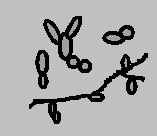|
Microorganisms
Bacteria
 The urinary infection is
the most frequently observed anomaly in urinary microscopy. The
presence of many white blood cells and bacteria is characteristic
of this situation. On the other hand, urine specimens for routine
examination are not usually obtained through a sterile technique
with the result that old specimens can have a lot of bacteria
with only a few leukocytes. The presence of numerous squamous
cells can indicate an external genital source for the bacteria.
In these two situations, a positive nitrite result may indicate a
urinary tract infection but a safe diagnosis is made only by a
positive culture obtained with a midstream specimen.
The urinary infection is
the most frequently observed anomaly in urinary microscopy. The
presence of many white blood cells and bacteria is characteristic
of this situation. On the other hand, urine specimens for routine
examination are not usually obtained through a sterile technique
with the result that old specimens can have a lot of bacteria
with only a few leukocytes. The presence of numerous squamous
cells can indicate an external genital source for the bacteria.
In these two situations, a positive nitrite result may indicate a
urinary tract infection but a safe diagnosis is made only by a
positive culture obtained with a midstream specimen.
Bacteria associated with urinary tract infection are mostly bacillus (E. Coli) but other shapes cannot be ruled out. Bacteria-coated urothelial cells are frequent in cystitis. This situation is different from Clue Cells, which are vaginal squamous cells coated with a coccobacillus (Gardnerella Vaginalis), forming a crust over the cell. Under the microscope, these latter cells have a granular aspect with a blunted border.
Yeast

 Like bacteria, the
presence of yeast in the urine sediment may indicate an
infection. A frequently seen yeast in urine is Candida.
Identification of this organism is relatively easy because of its
usual club shape. In the majority of cases, only the isolated
cells are seen but, in some cases, budding pseudohyphea may be
observed.
Like bacteria, the
presence of yeast in the urine sediment may indicate an
infection. A frequently seen yeast in urine is Candida.
Identification of this organism is relatively easy because of its
usual club shape. In the majority of cases, only the isolated
cells are seen but, in some cases, budding pseudohyphea may be
observed.
Other forms of yeast can be seen in the urine specimens. With a wet uncolored sediment, some of these forms are difficult to differentiate from red blood cells or some other elements. However, yeast contains DNA that can be demonstrated with an usual stain like the Sedistain™. This dye preparation stains yeast cells in blue.
In a number of specimens, the presence of yeast is the result of a contamination with vaginal secretion. Yeasts are often observed in specimens that contain sugar. It is important to be careful with these specimens because a yeast infection is a frequent finding with diabetic patients. Yeast containing casts have a very high clinical value; these are pathognomonic of pyelonephritis.
Parasite
 The parasite that is the more
frequently seen in urine is Trichomonas. Usually, this cell comes
from genital secretions contaminating the specimen. But
Trichomonas should be mentioned because cases of vesical and
prostate colonisation by this organism have been reported in the
literature.
The parasite that is the more
frequently seen in urine is Trichomonas. Usually, this cell comes
from genital secretions contaminating the specimen. But
Trichomonas should be mentioned because cases of vesical and
prostate colonisation by this organism have been reported in the
literature.
Identification of the living cell is quite easy owing to its spectacular motility. Identification of immobile cells is less obvious. Special stain can be use for Trichomonas. These stains can be found in the parasitology literature
Other parasites can be seen in the urine sediment. But these situations are rare and are mostly seen in exposed population. Identification of these parasites should be transferred to the parasitology department. This laboratory section has the tools and the expertise to make a proper identification.
Viral infection
Some cellular manifestations of viral infection can be seen in the urine sediment.To see these manifestations, the specimen must be stained. In some cases, phase contrast microscopy can be used but, a good staining procedure on a cytospin specimen gives a preparation that is easier to read. Identification of infected cells is within the scope of the cytology department. Suspected specimens should be transfered to the cytology lab.
- Herpes simplex is the most observed viral manifestation. The infected transitional cells will show a large eosinophilic inclusion surrounded with a clear halo.
- Cytomegalovirus is characterized by a bird's eye inclusion.
- Infection with the polyoma virus gives a cellular transformation formely named "Decoy cells". The enlarged nucleus is invaded by a huge basophilic inclusion.
Spermatozoa
 Urinary spermatozoa is a
contamination arising from sexual activity. With a male subject,
these represent a residual drainage while with a female, these
have a vaginal contamination source.
Urinary spermatozoa is a
contamination arising from sexual activity. With a male subject,
these represent a residual drainage while with a female, these
have a vaginal contamination source.
Some labs do not report spermatozoa. The problem with such a policy is that the labs rarely know all the elements to make a truly wise decision. Most cases are due to a normal human "activity" that should stay personal. But some cases, not necessarily known to the lab, are a result of reprehensible activity. Reporting the sperm cells found in a young girl's specimen is an easy decision but, cases of abuse are not always so obvious. We think that the lab should report all cases of spermatozoa and let the clinician decide what to do with the result.
Mucus
Mucus is a frequent finding of the urinary sediment. The exact function of mucus is unknown. Some think that this substance is a protection against bacterial infection. This action is done by coating the bacterial's pilis, essential to colonization of the lower urinary tract wall. The mucus coated bacteria are eliminated through miction. Mucus can also protect the lower urinary tract against irritating chemical agents.
 Mucus forming cells are found
scattered all over the urinary tract from the ascending section
of the loop of Henle to the bladder. Consequently, mucus can
originate from the kidney or from the lower urinary tract. Mucus
originating from the kidney is made of Tamm-Horsfall protein.
This explains the frequent association of mucus threads and
casts. In elderly patients, mucus is a frequent finding and seems
to originate from the lower urinary tract.
Mucus forming cells are found
scattered all over the urinary tract from the ascending section
of the loop of Henle to the bladder. Consequently, mucus can
originate from the kidney or from the lower urinary tract. Mucus
originating from the kidney is made of Tamm-Horsfall protein.
This explains the frequent association of mucus threads and
casts. In elderly patients, mucus is a frequent finding and seems
to originate from the lower urinary tract.
In the majority of cases, presence of mucus threads is a benign situation. An irritating factor could stimulate mucus secretion.
Contaminants and artifacts
The number of contaminating elements found in the urine sediment is surprising. Some of these artifacts are unavoidable, such as glass fragments, bubbles. Other artifacts are accidental, such as fibers and hair.
Starch or talc powder
 Since the advent of
systematic use of latex gloves by the hospital's staff, the
presence of starch crystals or sometimes talc has become very
frequent. The crystals are birefringent with a maltese cross
interference pattern when seen under crossed polarized filter.
The aspect of these crystals under bright field allows one to
easily distinguish them from the birefringent fatty droplets.
Since the advent of
systematic use of latex gloves by the hospital's staff, the
presence of starch crystals or sometimes talc has become very
frequent. The crystals are birefringent with a maltese cross
interference pattern when seen under crossed polarized filter.
The aspect of these crystals under bright field allows one to
easily distinguish them from the birefringent fatty droplets.


